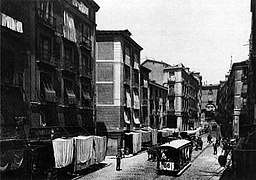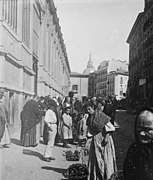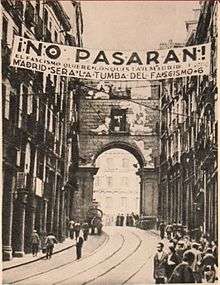Calle de Toledo
The Calle de Toledo is a historic street in central Madrid, Spain, running across the Centro and Arganzuela districts.
.jpg) | |
| Type | street |
|---|---|
| Location | Madrid, Spain |
| North end | Plaza Mayor |
| South end | Glorieta de las Pirámides |
History and description
Straddling along the Centro and Arganzuela districts, it starts at the Plaza Mayor and ends at the Glorieta de las Pirámides.[1] It was already named Toledo in the 16th century.[2] Until the late 15th century it ended at the Hospital of La Latina.[3] In the early 17th century the part near the Plaza Mayor was widened.[3] Following the 1790 fire in the Plaza Mayor, the buildings of the Portal de Cofreros were rebuilt with new materials following the anti-fire regulations dictated by Juan de Villanueva.[4] The street consolidated as one of the specialised commercial streets in the city centre by the early 20th century.[5] The image of the northernmost end near the Plaza Mayor became a part of the Antifascist collective memory with the photograph of the ¡No pasarán! banner[n. 1] hanged in the street during the Spanish Civil War.[6]
Some of the landmarks located in the street include La Fuentecilla[7] (at the junction with the calle de Arganzuela) and the Instituto San Isidro.[8]
 The street circa 1890
The street circa 1890 Female street vendors in the street next to the market of La Cebada (c. 1900)
Female street vendors in the street next to the market of La Cebada (c. 1900) ¡No pasarán! banner in 1936
¡No pasarán! banner in 1936
References
- Informational notes
- ¡No pasarán! El fascismo quiere conquistar Madrid / Madrid será la tumba del fascismo. "They shall not pass! Fascism wants to conquer Madrid. Madrid shall be the tomb of Fascism".
- Citations
- "Callejero Oficial del Ayuntamiento de Madrid" (PDF). Ayuntamiento de Madrid. 15 May 2017. p. 58.
- Peñasco de la Puente & Cambronero 1889, p. 529.
- Peñasco de la Puente Cambronero 1889, p. 529.
- Muro & Rivas 1994, p. 100.
- Miguel Salanova & Rodríguez Martín 2012, p. 2.
- Gil 2017; Mayayo 2018
- Alpuente 1994.
- Fraguas 2005.
- Bibliography
- Alpuente, Moncho (14 April 1994). "Heráldica y zoología". El País.CS1 maint: ref=harv (link) CS1 maint: date and year (link)
- Fraguas, Rafael (14 September 2005). "La mejor orla de Madrid". El País.CS1 maint: ref=harv (link) CS1 maint: date and year (link)
- Gil, Andrés (17 July 2017). "Del 'No Pasarán' a cuatro décadas de franquismo: 81 años del 18 de julio que desató la Guerra Civil". eldiario.es.CS1 maint: ref=harv (link)
- Mayayo, Andreu. "¡No pasarán!". In Vinyes, Ricard (ed.). Diccionario de la memoria colectiva. Barcelona: Editorial Gedisa. ISBN 978-84-16919-35-2.CS1 maint: ref=harv (link)
- Miguel Salanova, Santiago de; Rodríguez Martín, Nuria. "Modernización comercial y nuevas formas de ocio y consumo en el Madrid del primer tercio del siglo XX" (PDF). In Ibarra Aguirregabiria, Alejandra (ed.). No es país para jóvenes. ISBN 978-849860-636-2.CS1 maint: ref=harv (link)
- Muro, Fuensanta; Rivas, Pilar (1994), "Proyecto y realidad en la construcción del Madrid borbónico", Madrid y los Borbones del siglo XVIII: la construcción de una ciudad y su territorio (PDF), Madrid: Consejería de Cultura, Deportes y Turismo de la Comunidad de Madrid, pp. 87–114, ISBN 84-505-0871-1CS1 maint: ref=harv (link)
- Peñasco de la Puente, Hilario; Cambronero, Carlos (1889). Las calles de Madrid: noticias, tradiciones y curiosidades. Madrid: Establecimiento tipográfico de D. Enrique Rubiños.CS1 maint: ref=harv (link)